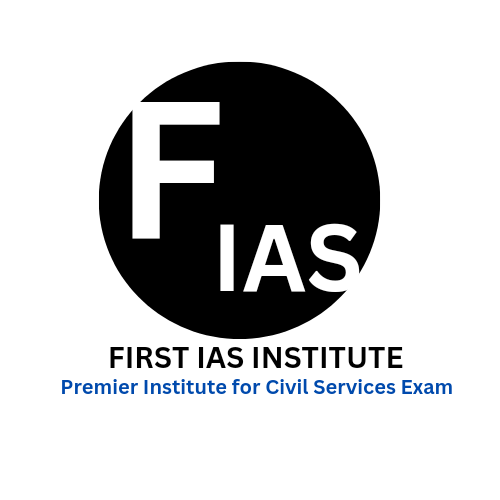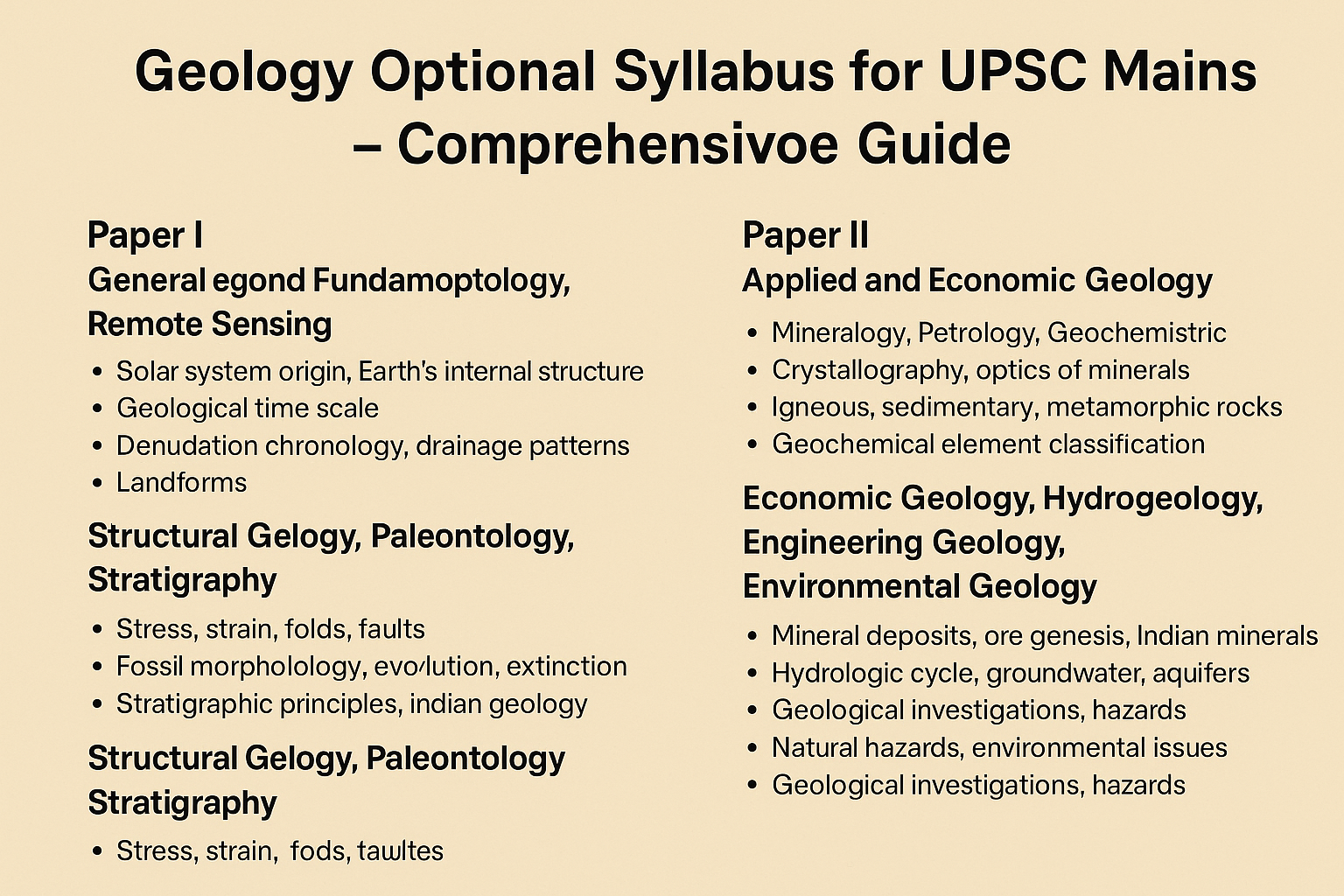Geology Optional Syllabus for UPSC Mains – Comprehensive Guide
Geology is a popular optional subject among science graduates for the UPSC Civil Services Mains Examination. It is known for its definable syllabus, illustrative answers, and scientific clarity. The subject is especially suitable for candidates with backgrounds in Geology, Geography, Environmental Science, Civil Engineering, and other earth science disciplines.
The Geology optional paper in the UPSC Mains consists of two papers – Paper I and Paper II, each carrying 250 marks, totaling 500 marks. Below is the detailed and descriptive breakdown of the Geology syllabus as per the latest UPSC notification.
Join WhatsApp community for Free Notifications, Updates, Study Material, Mock Tests, Internship Updates, and Current Affairs - CLICK HERE TO JOIN
Paper I – Principles and Fundamentals of Geology
Section A: General Geology, Geomorphology, Remote Sensing
- General Geology
- Solar system origin, age, and composition of Earth.
- Internal structure of Earth.
- Radioactivity and age determination of rocks: Radiometric dating methods.
- Earth's gravity and magnetic fields – principles and applications.
- Seismic waves and their interpretation in understanding Earth’s interior.
- Heat flow mechanism within the Earth.
- Geological time scale – standard divisions and the principles of correlation.
- Geomorphology
- Basic concepts of geomorphology.
- Denudation chronology.
- Drainage patterns and watershed classifications.
- Evolution of landforms:
- Fluvial (rivers and streams),
- Glacial (glaciers and periglacial landforms),
- Aeolian (wind),
- Coastal and karst topographies.
- Structural landforms and their significance.
- Geomorphic cycle concepts – Davis and Penck.
- Applied geomorphology in engineering, hydrology, and environmental planning.
- Remote Sensing and GIS
- Concepts of aerial photography and satellite remote sensing.
- Electromagnetic spectrum and its interaction with Earth surface features.
- Types of sensors and satellites (Landsat, IRS, SPOT, etc.).
- Applications of remote sensing in geological studies: mineral exploration, groundwater mapping, land-use classification.
- Introduction to GIS (Geographic Information Systems): data types, integration, and spatial analysis.
To Enroll in FIRST IAS INSTITUTE - Click Here
Section B: Structural Geology, Paleontology, Stratigraphy
- Structural Geology
- Stress and strain in rocks.
- Folds, faults, joints, and unconformities – classification and recognition.
- Tectonic structures and their significance.
- Plate tectonics theory – evidences, types of plate boundaries, and related structures.
- Structural mapping techniques.
- Stereographic projection – basic principles and applications in structural geology.
- Paleontology
- Fossilization processes and taphonomy.
- Morphology and classification of major invertebrate groups: brachiopods, trilobites, mollusks, echinoderms.
- Vertebrate paleontology – evolution of fishes, amphibians, reptiles, birds, and mammals.
- Gondwana flora and its stratigraphic significance.
- Evolution and extinction events – causes and consequences.
- Micropaleontology – foraminifera, ostracods; applications in petroleum exploration and environmental studies.
- Stratigraphy and Indian Geology
- Principles of stratigraphy: lithostratigraphy, biostratigraphy, chronostratigraphy.
- Geological time scale and correlation techniques.
- Stratigraphic succession in India:
- Dharwar Craton and Archaean-Proterozoic sequences.
- Cuddapah and Vindhyan basins.
- Gondwana Supergroup – flora, fauna, and paleoclimate.
- Deccan Traps and associated sedimentary formations.
- Siwalik Group and Himalayan geology.
- Stratigraphy of key Indian regions: Rajasthan, Assam, Himalayas, Western and Eastern Ghats.
Join WhatsApp community for Free Notifications, Updates, Study Material, Mock Tests, Internship Updates, and Current Affairs - CLICK HERE TO JOIN
Paper II – Applied and Economic Geology
Section A: Mineralogy, Petrology, Geochemistry
- Mineralogy
- Crystallography – crystal systems, symmetry elements, and classification.
- Optical mineralogy – properties of light under microscope; identification techniques.
- Physical and chemical properties of major rock-forming minerals.
- Classification of silicates and description of important silicate groups.
- X-ray diffraction and other modern analytical techniques in mineral identification.
- Petrology
- Igneous Petrology:
- Magma generation and crystallization.
- Classification and textures of igneous rocks.
- Forms and types of intrusions.
- Sedimentary Petrology:
- Processes of weathering, transportation, deposition, and lithification.
- Classification and structures of sedimentary rocks.
- Diagenesis and sedimentary environments.
- Metamorphic Petrology:
- Types and agents of metamorphism.
- Metamorphic textures, structures, and facies.
- P-T-t paths and regional versus contact metamorphism.
- Geochemistry
- Geochemical classification of elements.
- Goldschmidt’s rules and geochemical cycles.
- Distribution of elements in crust, mantle, and core.
- Geochemistry of igneous, sedimentary, and metamorphic rocks.
- Isotope geochemistry – principles and applications (C, O, S, Sr, Pb isotopes).
- Applications in petrogenesis and mineral exploration.
To Enroll in FIRST IAS INSTITUTE - Click Here
Section B: Economic Geology, Hydrogeology, Engineering Geology, Environmental Geology
- Economic Geology
- Classification of mineral deposits – metallic, non-metallic, and fossil fuels.
- Controls of ore localization – structural, stratigraphic, and lithological.
- Ore textures and structures.
- Origin of important mineral deposits – magmatic, hydrothermal, sedimentary, and metamorphic.
- Indian mineral deposits:
- Iron, manganese, chromite, bauxite, copper, lead, zinc, gold.
- Industrial minerals – limestone, mica, gypsum, phosphorite.
- Energy resources – coal, petroleum, natural gas, atomic minerals.
- Mining methods and mineral economics.
- Hydrogeology
- Hydrologic cycle – precipitation, infiltration, runoff, evapotranspiration.
- Properties of water-bearing materials – porosity, permeability, specific yield.
- Aquifer types – confined, unconfined, perched; artesian wells.
- Groundwater flow mechanics.
- Groundwater exploration techniques – geophysical and remote sensing methods.
- Water quality standards and issues of groundwater contamination.
Join WhatsApp community for Free Notifications, Updates, Study Material, Mock Tests, Internship Updates, and Current Affairs - CLICK HERE TO JOIN
- Engineering Geology
- Geological investigations for construction – dams, tunnels, highways, buildings.
- Rock mechanics and geotechnical classification.
- Landslides and their mitigation.
- Seismic zoning and geotechnical hazard assessment.
- Case studies of major Indian engineering projects and geological considerations.
- Environmental Geology
- Natural hazards – earthquakes, tsunamis, floods, landslides, volcanism.
- Environmental impact of mining, quarrying, and industrial activities.
- Waste disposal and land reclamation.
- Use of geoinformatics in environmental monitoring.
- Groundwater management and water resource sustainability.
- Climate change and its geological indicators.
To Enroll in FIRST IAS INSTITUTE - Click Here
Conclusion
The Geology optional syllabus for UPSC is a perfect blend of theoretical understanding and applied knowledge. Candidates opting for Geology must focus on diagrammatic representation, clarity of concepts, and real-world applications. With a scientific approach and logical answers, aspirants can effectively score high in this optional subject.


 firstiasofficial@gmail.com
firstiasofficial@gmail.com
Leave a Comment